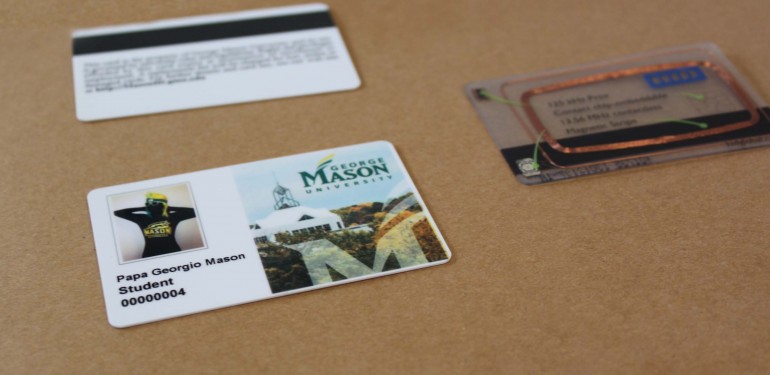Mason plans to introduce new ID cards this spring for students, faculty and staff. They will employ more sophisticated technology than the ones currently in use, replacing the barcodes with computerized chips.
“We’re moving to an ID that has a chip on it as well as a [magnetic] strip,” said Mark Kraner, executive director of campus retail operations in the Auxiliary Enterprises department. “The idea is that we can provide a higher level of security to everybody by not having all of the data on the strip, which is not encoded.”
The new chip will allow students to access many places on campus by scanning their IDs instead of swiping them. This marks an improvement in terms of convenience, providing easier access to individuals in wheelchairs and with physical disabilities, as well as security. Whereas the old cards constantly send out signals that can be captured by recorders, the updated ones should only work if the reader detects the proper code, preventing students’ information from being stolen.
Another component of the switch is that students will receive ISO or International Standard Organization numbers in addition to their G numbers. The ISO number serves as extra protection in case an ID card is lost or stolen; when students receive new cards, they will also get new ISO numbers, which cannot be tracked, and the lost or stolen card can no longer be used.
Because of the added technology, the new ID cards will be more expensive, costing $20 each.
The ID card change represents one step in improving the university’s security as a whole as security issues have occurred in the past. Mason looks to update its procedures and tools every five to six years.
“The federal government has set up new standards for ID cards across the board, and we’re coming to those standards,” Kraner said. “Our goal is to create a secure environment with the ID card.”
Eventually, Mason plans on adopting a multi-factor identification system, which would require students to present more than one form of identification. For example, they could have to put in a PIN number as well as scan a card.
Some buildings and rooms already have new readers in place, though these still have a swipe capability since the transition will take a while to complete.
“Our first roll-out is going to be to the incoming freshman class, and then the next incoming freshman class,” Kraner said. “After that, we’ll push for anybody that’s left that hasn’t changed their ID card to come in and get a new ID card. It’s a three-year phase so the cost is minimized.”
In theory, the chips embedded in the new ID cards can hold information beyond basic personal data. It is possible that they could, at some point, contain students’ classes and medical records for easy access, though Mason has not approved any measures along those lines.
“If the police walk up and scan the card, they can get the information they need quickly as to home address and so forth because it could be stored there,” Kraner said. “The university hasn’t chosen to go there yet, just because it’s new and everybody has to weigh what we’re doing and make a decision. But the potential is there that we could have that information.”
Kraner also mentions that Mason is looking to forge an agreement with the Washington Metropolitan Area Transit Authority that would allow students to use their Mason IDs to ride the subway.
The news will be officially announced when Fenwick Library installs its readers, most likely sometime around spring break.
Featured image credit: Amy Podraza




